Those of you who are just stepping into the bowhunting arena have probably stood (or are about to stand) like a deer in the proverbial headlights in front of the broadhead displays of your favorite sporting goods store. Don’t feel bad about it. The choices are many and, to the beginning bowhunter, trying to make the best pick can be downright confusing.
Of all the bowhunting accessories available today, few can match the sheer styles and variations of broadheads. There are fixed blades and replaceable fixed blades with two, three and four blades. There are mechanical heads with multiple-blade options as well, compounded by the choice of actions xe2x80x94 front- or rear-deploying. Many of these models come in different weights. You have options in material construction, including stainless steel, aluminum alloy and titanium. Now, multiply all the above by an astonishing number of manufacturers that are in the game.
Yeah, it can give you a headache.
There are many sources out there to help you in your search for a quality broadhead. What we want to do here is give you the basics to consider so that you have some elemental knowledge to guide you when you head to the store.
Fixed vs. Mechanical Broadheads
Fixed-blade broadheads have blades that are either built into the ferrules or that utilize replaceable blades that fit into slots along the broadhead ferrule. For most of the history of bowhunting, these were all we had, and they still work well. Shoot a deer, clean up the broadhead, add fresh blades, make sure the point is still sharp, and repeat.
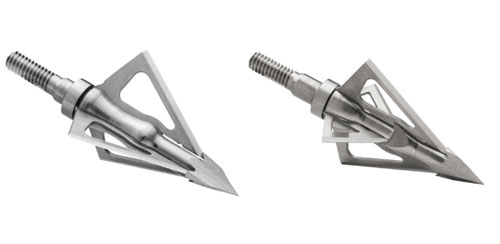
As technological advancements brought us faster bows, lighter arrows and smaller vanes, some bowhunters began to have difficulty shooting fixed-blade broadheads. This was due to the aerodynamics of the broadheads and the inherent flight instability of some models when used with fast bows shooting lightweight arrows. Tuning your equipment for reliable shot placement became, for some, an exercise in futility. Field points shot fine. Broadheads … not so much.
Then along came expandable broadheads with blades designed to open on impact and stay open as the arrow continued through the animal. The execution of some of these broadheads left a bit to be desired, but the concept proved sound. Since the blades of a mechanical broadhead remained in their closed position in flight, the tendency to wind plane and veer unpredictably off target greatly diminished when compared to some fixed-blade models.
As mentioned, mechanical broadheads deploy their blades in a couple of ways. Rear-deploying blades expand outward from the back of the ferrule as the point enters the target. The broadhead pushes into the hide and as the forward ends of the blades make contact, the pressure pivots the blades outward into their open position. With front-deploying blades, that same pressure pushes against the blades so that they open like a flower and eventually flip back into a delta configuration before continuing into the target.
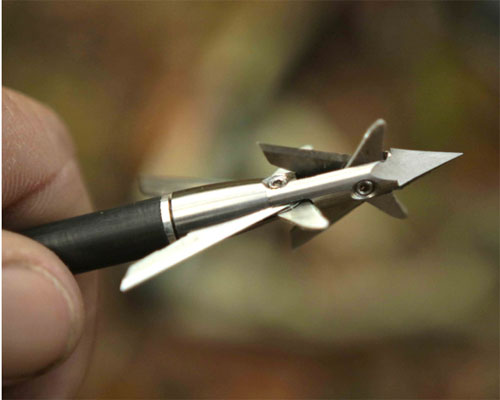
Both deployment actions work well in properly engineered designs. Some bowhunters advocate one style and others prefer the opposing style, although we’ve found that rear-deploying blades seem to work most reliably for our setups.
One of the advantages of most expandable broadheads is that they tend to offer a larger cutting diameter than nearly all fixed blades. With cutting diameters exceeding 2 inches in some models, mechanical heads can offer a huge advantage if wide cuts and generous blood trails are your objective.
Which Broadhead to Choose
If we could have our ‘druthers, we would probably lean toward fixed-blade broadheads because their simpler design means there’s less chance of something going wrong. Fixed-blade heads are also hard to beat from a penetration standpoint. Cut-on-contact fixed-blade broadheads xe2x80x94 especially those like the TRUGLO Titanium X fixed-blade heads shown above that have a continuous edge from the ferrule tip all the way to the back of the blade xe2x80x94 offer the best penetration you can get with a fixed three- or four-blade head. In addition to their full-length cutting surfaces, the rigidity of fixed-blade heads is a tremendous asset when encountering bone. The ability to punch through bone, such as ribs or scapulas, and keep the blades intact to cut through the vitals on the other side is one reason many bowhunters are reluctant to make the switch to mechanicals.
That said, our most devastating wound channels and quickest moment-of-drop times (under 10 seconds) have come from double-lung or heart pass-throughs using two-blade mechanicals.
Since broadheads don’t come cheap and few of us can afford to buy several models at a time to see what works best with our equipment, our advice is as follows:
Recurve/Traditional Bowhunters
Go with a fixed-blade broadhead. The slower velocities and typically heavier arrows sporting four-inch feathers means that the fixed broadhead is probably not going to destabilize the arrow in flight. The fixed-blade head will almost always fly true if your arrow spine is correct for your draw weight and length and your string nock is properly set. Although a mechanical headshot from a traditional bow will certainly fly true, some hunters have reported blade deployment issues and a reduced tendency for achieving pass-through shots xe2x80x94 especially in bows with draw weights under 50 or 55 pounds.
Crossbows Hunters
Modern crossbow hunters have, for the most part, the luxury of choosing either fixed-blade or mechanical broadheads.
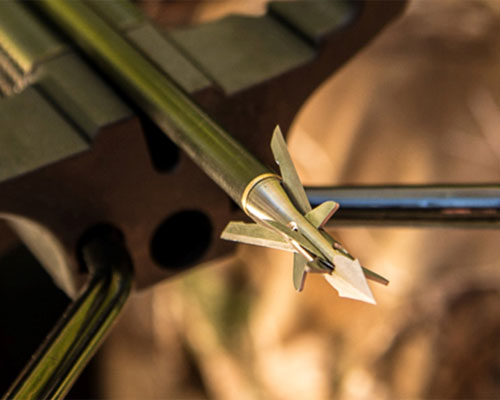
Although some crossbows today are wicked-fast (over 400 fps), the predictable arrow launch characteristics of a crossbow combined with ample fletching and a relatively robust shaft weight means that most precision-made fixed-blade broadheads will fly well from a crossbow. Still, you need to test them before heading into the woods. Our experience has been that the larger the fixed-blade broadhead cutting diameter, the more wind planning we picked up when launching from a crossbow. Go for smaller cutting-diameter heads (around 1 1/4 inches) for best results with fixed-blade models.
Mechanicals also work well with crossbows. The key here is to find broadheads that are specifically rated for use in crossbows by the broadhead manufacturer. Because crossbows launch their arrows so hard and fast, broadheads not designated for crossbows could open prematurely (prior to impact). Opening in mid-flight will make the arrow unstable, and a miss or poor shot is sure to follow.
Conventional Compound Bowhunters
As with crossbows, vertical compound bows can launch both fixed-blade and mechanical broadheads with great precision. Largely, though, mechanical broadheads have become mainstream for the compound bow shooter because they exhibit more predictable and stable flight characteristics similar to the field points used for practice. That is not to say that all mechanical broadheads fly perfectly or the same as field points xe2x80x94 they do not. You will need to shoot them during practice sessions to fine-tune them to your equipment set up.
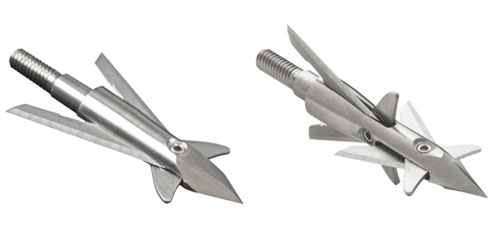
While consistent point-of-impact is the priority of a broadhead, terminal performance is also important. As mentioned, mechanical broadheads, with their typically larger cutting diameter, deliver an exceptionally large wound channel that, when combined with a pass-through shot, leaves a blood trail to dull the tracking arts. We rarely need to track deer shot with a 2-inch plus mechanical head because they simply don’t go that far if you sink it through the vitals.
Broadhead Construction
One final consideration when purchasing broadheads is the material used to make them. For years, broadhead ferrules were made almost exclusively of aluminum alloy. Many are still are made that way because the material is light and easy to machine.
A stronger alternative that has become popular is stainless steel. The acknowledged best material for broadhead, though, is titanium. It is strong yet relatively light and is unmatched in terms of durability. Essentially, titanium broadheads offer the best of both worlds with the added advantage of longer life than either aluminum alloy or stainless steel.
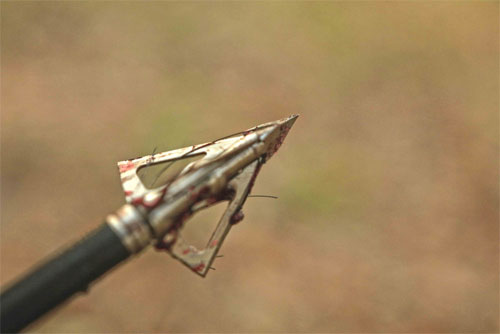
As for blades, whether fixed or mechanical, go thick and go stainless steel. Most blades with a thickness of .03 inch or greater are going to have the stamina to punch through big game. Our advice is to go ahead and buy a set of replacement blades when you purchase your broadheads because once season begins, dealer stock often dries up and you want those replacements on-hand.
Lastly, the choice of whether to use fixed-blade or mechanical broadheads may be out of your hands, depending on where you hunt. Some Western states, for example, prohibit the use of mechanical broadheads on heavy game animals like elk or moose. Those mandates are guided by the solid construction of fixed-blade heads and their proven ability to offer maximum penetration when launched from bows of typical hunting weights for those species.
Selecting the right broadhead from shelves and pegboards packed with various models can be a tad overwhelming for the beginning bowhunter or crossbow hunter. By keeping in mind these general guidelines when you head to the archery shop or hop online, you’ll be better able to make a solid choice for your setup and your particular bowhunting needs.
Editor’s Note: The TRUGLO Titanium X broadheads featured in this article include a $5 rebate when purchased now through October 31, 2019.
xe2x80x94 PAID PARTNER CONTENT. This content is brought to you by a D&DH advertising sponsor.











































